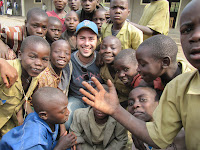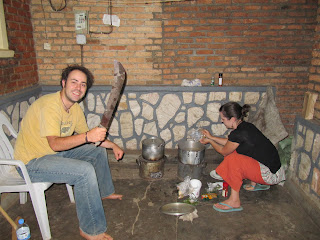
Thanks for all of the feed-back everyone. It is great to have your support and to hear from you. We have gotten a bit busier with work and classes start soon, so I have not had much time to write an update. So, here is a condensed version of what we have been up to!
Finally, I was able to get back in the field. It’s been exactly a year since I left HSCV and I have missed the work. I’m not the academic type, and I have been willing myself through assignments knowing it would lead me back to the field.
Last Monday afternoon I left Kigali with 4 staff, including our driver. Rwanda is small and even the most remote areas take only 5 hours to reach from Kigali (please don’t mind the rutted and washed out mountains roads). We headed to the Northern Province to visit and investigate a new Development Area (DA) in the Muko Sector. It took us only 2 hours to climb the mountains and reach our destination. The drive was amazing as we drove up the windy, twisted mountainside. It has been awhile since I’ve been on such windy roads, but comparably to most countries (US excluded) the Rwandan traffic and drivers are tame. Rwanda has 5 of the 8 volcanoes that make up the Virunga chain, with the remaining 3 in the DRC. Unfortunately we were clouded in, and I was only able to see a faint outline of one of the volcanoes in the distance.

Upon arrival in Muko sector of Musanze district we meet with the local leaders. This trip was a fact finding/ introduction our mission. This is a new sector for our work, and it was extremely interesting to see their “rights based” approach in action from the very beginning. So far I have been very impressed with their approach and commitment they make to insure the development is happening from within. Any programs funds must come from the desire of the community. This is to stay, if they build a school, it because the local community leaders (not just the officials, but the teachers, PTA, religious leaders…) have advocated for it. AAIR acts by informing the locals of their rights (land rights, access to education, women’s rights…) and helps them learn how to obtain those rights for themselves. It is a bottom-up, top-down approach that seems to be working.
But, enough of the technical aspect of what I’m doing, which may not be as interesting to you as it is to me (I just get very excited about these things). The time in the north was absolutely wonderful. I was asked to interview a few people to create a profile for our poverty analysis of the new sector. I ended up speaking to 4 people, 3 women and 1 man. Their lives are very difficult. The land is very scarce since Rwanda has the highest population density of in Africa and over 90% of the population engages in agriculture of survival. The Rwanda’s have also traditionally had very big family as a means of security (more children to help you when you are old and a better chance of having a child that make it into adulthood). However, the reality is child mortality rates are dropping at very high rate and fertility rates are remaining at about 8 per woman. This is putting an even higher burden on the limited land and resources. Part of AAIR's advocacy focuses on family planning and education related to these issues. Needless to say their challenges are immense and it can be overwhelming to hear their stories and to try to understand how great the need really is.
Their children are so sweet and so excited to see a westerner for the first time. Many of them run up to touch and say hello and try out their English, some become speechless and others cry and run to their mothers. Once the camera comes out and the snapshots are shared; the excitement is hard to contain. They are really, really beautiful children.
Later in the week Emily and I were asked to travel to the Southern Provence to help collect “stories” that will be used in a community newsletter that is sent to sponsors. The South isn’t as “mountainous” as the North, but the hills in this country are never ending. Rwanda called the “Land of the 1,000 hills” for a very good reason, but really there are so many more than 1,000.

On the first day we visited 2 schools within the Nynaze district. The first is in the process of building a playground for the students. The local PTA is the brainchild of the project. They have overseen the construction and the parents were hired to participate in the building. This is not only a source of revenue for the family, but it also builds ownership into the project. The parents and the children really view the playground as theirs and they have all vowed to care for and protect the playground. The second school was a newly built and will be used for the upcoming school year. The old school was a very difficult 2 hour walk up hill. The school had great difficulty recruiting and retaining teachers as well as students. The new school will help the areas children stay in school and continue their education. An important addition to the new school are the 12 new and private toilets for the children to use. This basic need is a major cause of girl students dropping out of school. Once a girl reaches puberty, their period can become a major point for boys to bully them.

On the second day we traveled another 3 hours into to the remote Southern mountains that border Burundi, to the district of Rhanza. At one point we were able to see Burundi, given the declining state of security in Burundi this is likely to be the closet we will get. This school has also built new toilets and classrooms. The school currently has over 1,500 students with over 40 children to a classroom on split shifts. Some of the classrooms they are using were built in the 1950s. They are more or less made of mud brick walls with dirt floors. Before AAIR’s support most of the classrooms did not have desks or chairs for the students. The children sat on stones or logs, without a writing desk. The classrooms were also very dark, no electricity and only 2 windows in each room, a very hard environment to learn anything.
I was impressed by the teachers and the parents dedication to their children’s education. As with the other schools, they were built because of the PTA advocacy and ultimately built by the parents.
We were also fortunate to be introduced to the Sara Club. The Sara Club was stated 2 years ago. The group is managed by students with the support of teachers. The Sara Club is combating such issues as bullying and Gender Based Violence (GBV) through education, peer consoling, singing and dancing.
The girls preformed a song and dance for us and it was the most amazing performance. The girls were very proud and dedicated to the performance. Their positivity and warm spirits filled the school yard.

The average age in the Sarah Club is around 13, but Divine is by far the youngest at 5 years old. She does not yet attend school, but when heard about the Sara Club’s dancing and singing she couldn’t resist. She attends every meeting, practice and event. When asked how she feels about the Sara Club she is shy and recoils, but when she is on stage she is all business. She dances with great concentration and seriousness, keeping in step with girls 10 years her senior. She is my new hero.
Well, I have gone on for much longer than I thought I would. I hope you haven’t been too board by all of my development speak, I’ll try to minimize it next time. Enjoy your weekend and I’ll send a new update soon!

 Overall I found the children more open and easier to get to participate than the adult focus groups. We played a few games at the start and in the middle of the group meeting. This seemed to help the children feel comfortable and open to the idea of the group. We also provided each child with a Fanta and a muffin at the start of the group meeting.
Overall I found the children more open and easier to get to participate than the adult focus groups. We played a few games at the start and in the middle of the group meeting. This seemed to help the children feel comfortable and open to the idea of the group. We also provided each child with a Fanta and a muffin at the start of the group meeting.  Household Surveys
Household Surveys 








































